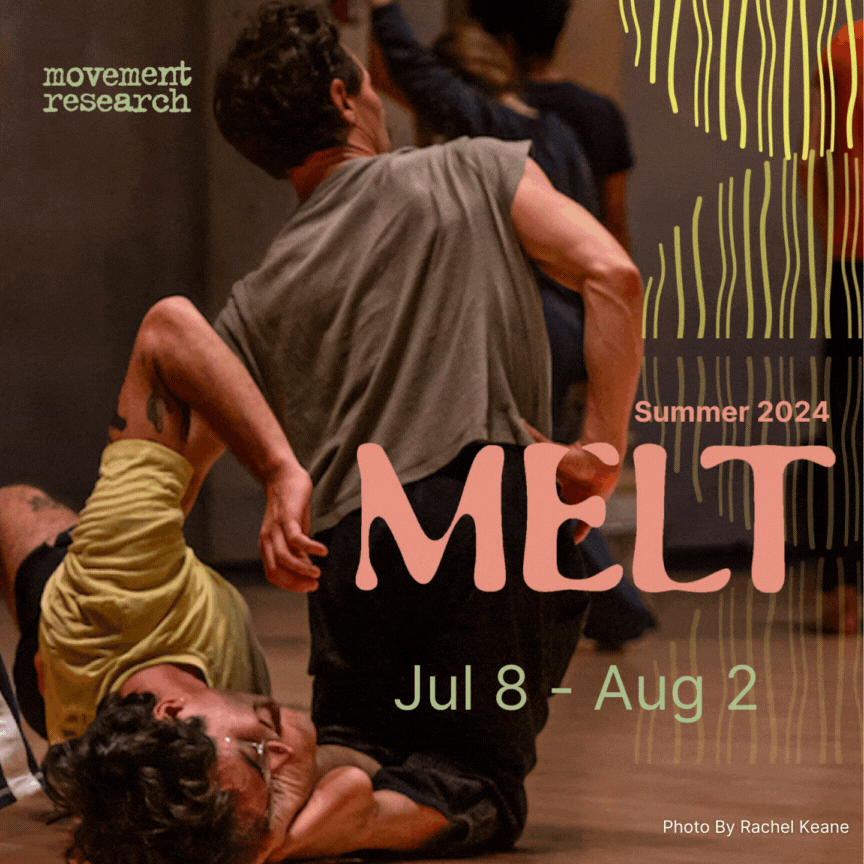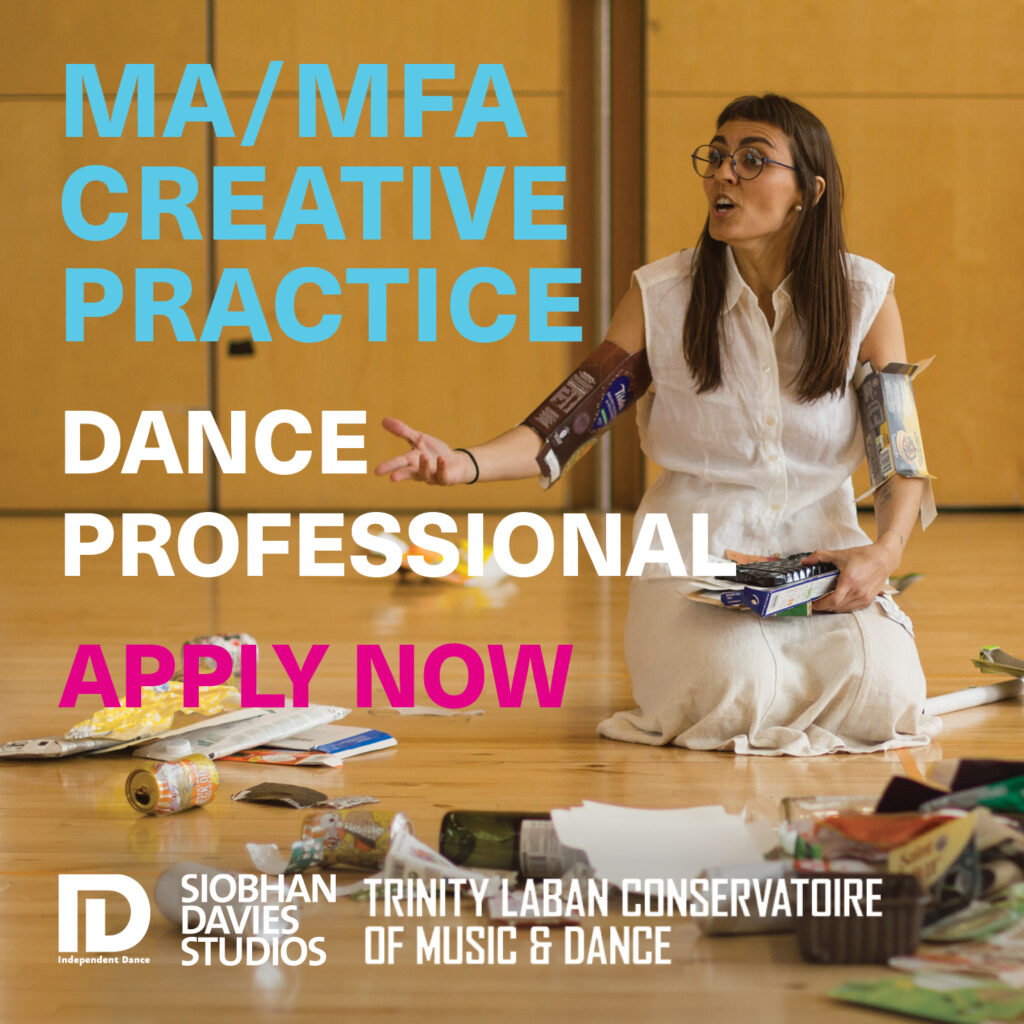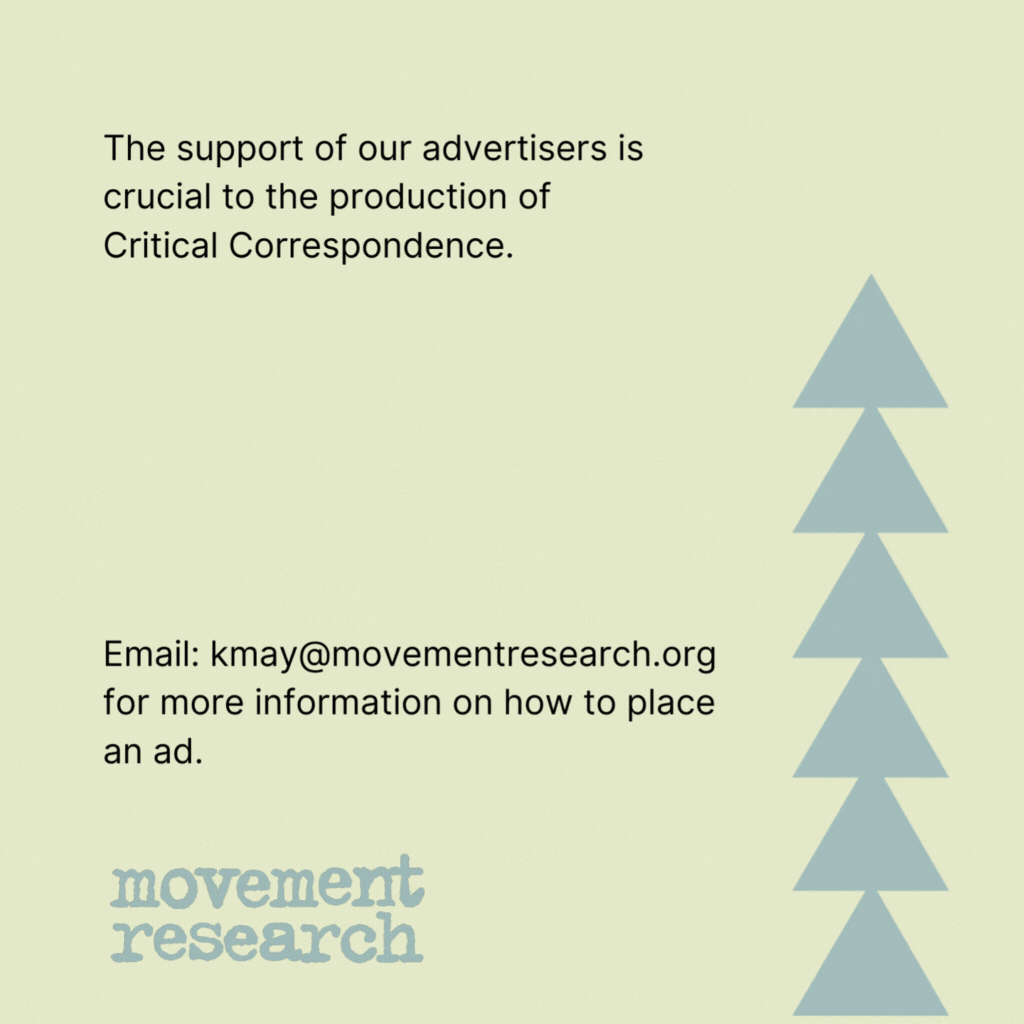1) What are the most potent questions prompted by the recent coming together of dance and the visual arts?
Dance and the visual arts, of course, have a relationship that has goes back much farther than the past decade or so. Early examples come up throughout RoseLee Golderg’s volume Performance Art, for instance—from Italian Futurist painters like Giacomo Balla and Enrico Prampolini working with live dancers near the beginning of the 20th century to the 1917 ballet Parade, which brought together Erik Satie, Pablo Picasso, Jean Cocteau, and Léonide Massine. And many writers have extensively covered the way in which the choreographer Merce Cunningham collaborated with visual artists throughout his career. Other well-known examples of choreographers who regularly collaborated with visual artists include Trisha Brown, Lucinda Childs, and Anna Halprin, to name a few.
Given that history, the most potent questions about dance and visual arts in this particular cultural moment are tied up in how the two are coming together differently than before. And most immediately, the focus of much of the conversation seems to be less about collaborations between dance and the visual arts, but instead about contextual shifts—literally dance being done in spaces that are not traditionally dance or live performance spaces. Again, this isn’t something entirely new—choreographers like Rosemary Butcher and William Forsythe have long been creating work specifically to take place outside of dance spaces; purposely bringing architecture, design, visual media, and questions about the relationships between bodies, objects, and images into their work.
What seems to be beneath the surface (and sometimes very much on the surface) of the discussions happening today around dance and visual arts is the sense that in some cases dance is simply being brought in as a novelty to enliven otherwise relatively static visual arts spaces. With that, there’s a concern that there aren’t strong artistic or philosophic reasons behind the change in context. In other words, it can feel like dance is just being plopped into museums, rather than presenting work that was intentionally created with the museum in mind.
Further, a change of venue for live performance brings up a number of very practical concerns. For example, dancers don’t generally perform on a regular basis in spaces without sprung floors because it’s terrible for their bodies in the long-term. Museums and art galleries are often poor venues for the demands of dance and performance simply because they lack the proper facilities—besides the lack of appropriate flooring, they often lack dressing rooms or private bathrooms with showers near the performance space, nor do they usually have “off-stage” space where dancers can exit temporarily during a performance.
Another practical concern in visual arts spaces is money. As I, and many others, have discussed elsewhere, museums and galleries are used to getting away with not paying any of the artists they show. The value proposition that visual arts spaces present to artists whom they fail to pay is that the exposure is payment enough—that showing their work opens up the possibility for future sales, so they don’t need to be paid now. That value proposition is falling flat more and more with visual artists, but it’s especially flat when it comes to performance work. Bodies cannot be bought and sold in the way objects can, nor can a work of choreography or an improvisational creation be purchased as readily as a sculpture. The economics and value propositions of dance, for both dancers and choreographers, are not infinitely better than the visual arts world, however, there is a clearer understanding that the need for lengthy rehearsals and the physical demands on dancers’ bodies should be acknowledged in some way. As a result, many professional dancers receive payment for their time and labor. Therefore, in a context where the demands are increased because conditions are less suited to the work, compensation becomes even more of an issue.
The final pragmatic concern about shifts in venue is that dance is typically done in an environment of undivided attention, whereas museums and galleries are inclined toward constantly divided attention. Audiences graze in a gallery, passing in and out of rooms, looking at some works only in passing while spending a bit more time elsewhere. In performance spaces, people are typically asked to sit, to look generally one direction, to absorb and sometimes actively participate in what’s happening, and the implication is that they should stay for the performance’s duration. Therefore the relationship to the audience in the two venues is radically different, and the relationship an audience member has to a dance that they pass by for only a moment is quite different from the relationship an audience member has to a piece of choreography that they see to completion.
All of which is to say, there can be reasons for bringing dance into visual arts spaces that are meaningful and rich with possibility—some choreographers have been doing this for decades. However, where it’s the case that dance is simply being invited into a new setting, it’s crucial for both dancers and critics to ask questions about that shift in context. What is lost and what is gained? If museums and galleries are going to genuinely engage dance and live performance, they need to get much better at dealing with the realities of having live performers in their space—updating/changing their facilities, looking for artists whose work derives part of its meaning from shifting contexts, and presenting the work to audiences in a way that helps the audience have a full experience of the work.
2) What are the responsibilities and/ or challenges that accompany this interaction for artists and curators?
Artists must ask themselves hard questions any time they get an invitation to present anywhere, but particularly when they are being asked to present outside of their field. A choreographer should ask, are the conditions and economics of the situation truly beneficial to me and my dancers—how likely is it that exposure will really generate new opportunities? What have the experiences of other artists been in this space? How will I and the dancers be compensated or acknowledged for our time and protected against the risks of the space in which we’ll be performing? Does this context actually suit my work—what interesting new conversations can be had; what conversations already exist in my work that can be highlighted in this space?
If the conditions aren’t adequate, demand adequate conditions. If those demands aren’t met, say no to the performance. Similarly, if minimum payment demands aren’t met, say no to the performance. And consider publicizing your non-participation in a clear and professional way to call attention to situations that are likely not unique to you. In the long-term this can help not only you but the field at large in creating stronger professional standards and better working conditions for everyone. One of the only ways we can halt exploitation and backward value propositions is by refusing to participate in them and publicly articulating why they are unacceptable.
Similarly, curators, arts writers, and scholars should look past the simple novelty of seeing something in a different setting and ask serious questions of their own. Why is this work happening here, now, in this space? An enormous amount of the meaning and experience of any performance work is derived from the context in which it happens. Did the artist make conscious choices about the context? Did the institution? What is the audience’s experience of the work, etc?
3) As artists, audiences, and institutions with varied artistic backgrounds come together, on what grounds is it or is it not important to consider disciplinary/ generic boundaries?
Each genre and sub-genre of the arts speaks its own language, tied to its history and the training of those who participate in it. But artists have long been interested in and influenced by work outside of their genre or field. It’s never enough to limit the conversation about a given artwork to assumptions about influences within one field. That said, the vogue for multi-disciplinary work can become an end in itself, where artists, funders, and institutions push for work that crosses multiple boundaries simply for the sake of doing so or because of untrue assumptions about innovation always deriving from the clash of forms. Innovation takes many forms in the arts. I believe it most often comes from artists who persistently follow a line of inquiry, in whatever genre(s) they feel drawn to. Imposing shifts in context and boundary on an artist can occasionally be fruitful, but my sense is that the better work comes from the artist themselves following the winding path of inspiration, questions, and what-ifs that drive their work.
4) What might the meeting of dance and visual art at this time herald or reflect? Or, why is this happening now? What possibilities might it open for the future?
As a society, there seems to be a lot of interest in the functioning of networks and novel live experiences. Tourism is now one of the leading industries worldwide and contrary to the popular belief that social networking websites isolate people, the Pew Internet & American Life Project found that “the average user of a social networking site has more close ties and is half as likely to be socially isolated as the average American.” All of which is to say, people are connecting more, not less, and want to have unique in-person experiences. Live performance has always provided people with novel experience, and as visual arts spaces with frequently static collections and exhibitions seek to maintain audiences in the face of fading subscription and membership models, engaging more with live performance is a natural, if sometimes cynical or easy, choice. The challenge for visual arts institutions is to engage live performance in a genuine and meaningful way. And the challenge for artists is to hold true to their work and the conditions necessary for that work to succeed.
Alexis Clements is an arts writer and playwright based in Brooklyn, NY. Her performance work has been presented at venues such as Dixon Place (NY), Women’s Project (NY), River-to-River Festival (NY), University Settlement (NY), Emerging Artists Theater (NY), Brooklyn Arts Exchange, Riverside Theater (Iowa), the Edinburgh Fringe Festival, and the Philadelphia Fringe Festival, among others. She is the co-editor of the two-volume anthology of plays, Out of Time & Place, which includes her performance piece, Conversation. Her articles, essays, and interviews have appeared in publications such as Salon, Bitch Magazine, American Theatre, The Brooklyn Rail, The L Magazine, Nature, and Travel New England. She is a regular contributor, focused on art and performance, to Hyperallergic. In addition, she co-founded a queer writing group based in Brooklyn. She has a M.Sc. in Philosophy & History of Science from the London School of Economics and Political Science and a B.A. in Theater Studies from Emerson College. www.alexisclements.com






